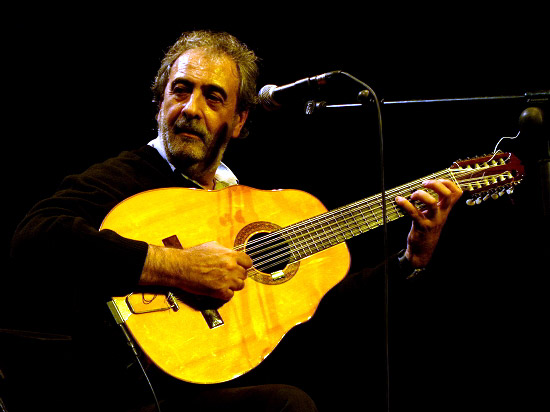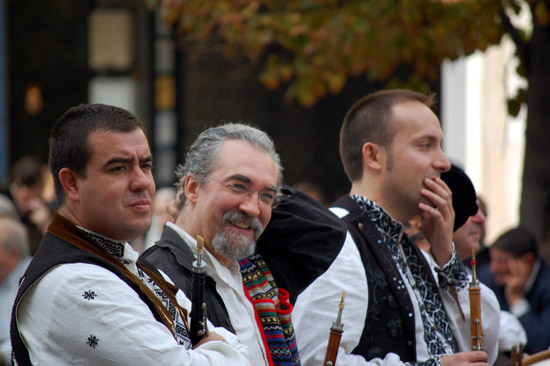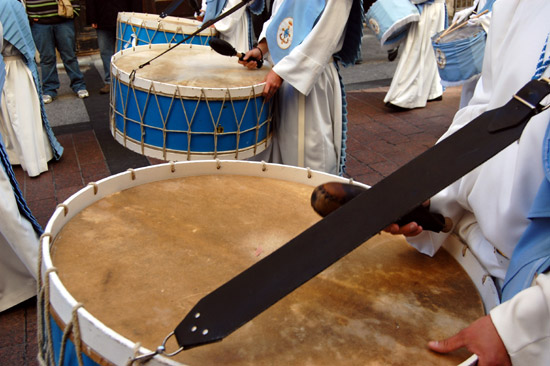Music: Instruments and Ensembles
Chordophones
In addition to the classical guitar, which was designed by Antonio Torres and popularized by Andrés Segovia, Spain is home to a number of other string instruments.
Bandurria
The bandurria is a mandolin-type instrument that can also be found in the Philippines and South America. Its form is similar to that of a guitar, but the body is teardrop-shaped, the neck is much shorter than that of a guitar, and it features six double-courses of metal strings.
Guittaro
The guittaro is also shaped like a guitar but is smaller in size and has four or five nylon strings, sometimes featuring double courses on the three middle strings.
Zanfona
Spanish music also features the zanfona, a hurdy-gurdy built in a guitar-like form, with three melody strings and two drone strings. Hurdy-gurdies are played by turning a crank, which causes a rosined wheel to rub against the strings of the instrument. This variation of the hurdy-gurdy lacks a buzzing bridge.
Aerophones
Gaita de Boto
The gaita, also referred to as the gaita de boto to differentiate it from other kinds of wind instruments referred to as gaitas, is a bagpipe from the Aragón region of Spain. Its large air bladder is traditionally made of goatskin. The instrument features a blowpipe, a double-reed chanter with seven finger holes and a thumb hole, and two drones—one bass, one tenor.
Dulzaina
The dulzaina is an oboe-like instrument that comes in a number of varieties throughout Spain. This double-reed instrument was initially introduced to Spain by Arabs; closely related to the Arabic mizmar and Turkish zurna, it lacked flute keys until the 20th century.
Pitu
The pitu is another cone-shaped reed woodwind, but with a single reed. It features seven finger holes and a thumb hole, and is played similarly to the chanter on a bagpipe (though mouth-blown).
Requinta
The requinta is a small transverse flute, fife-like, with only six finger holes. Both instruments are typical to Galicia and Asturias, and are only two examples of numerous woodwinds traditionally played in Spain.
Idiophones
Many percussion instruments contribute to the various musical styles found throughout Spain.
Tamboril
In Galicia the tamboril is a snare drum that is hung from the belt of the musician and struck with a pair of sticks.
Bombo
The bombo is a bass drum played with a single stick; both it and the tamboril often accompany bagpipes.
Pandeiro
The pandeiro is a square frame drum that was also once popular throughout Galicia. The round form of the same drum is known as the pandeira; the instrument can be played with either one or both hands. The square pandeiro can be compared to the originally Moorish adufe, which is played in Portugal. A small pandeira called a pandeireta is held in one hand and struck against the other hand, as opposed to being held in the stationary hand and struck by the other.
Castanets
The castanets are an ancient percussion instrument well-known for their modern appearances in flamenco performances. Records indicate that they existed as early as 1000 BCE. Each castanet is made of two cupped pieces of usually chestnut wood, which is drilled to accommodate a cord that is wrapped around the thumb of the player. The higher-pitched castanet of the pair is known as hembra, while the lower-pitched one is called macho; the cups are manipulated by the fingers to generate sound.
Cajón
Other percussion instruments of Spain include rattles and the cajón, a box-shaped drum originally from coastal Peru and Cuba, where it was developed out of shipping crates by African slaves; in the 1970s, Paco de Lucía introduced the cajón to flamenco musicians, who adopted it as part of the standard ensemble.
Article written for World Trade Press by Cam Waller.
Copyright © 1993—2025 World Trade Press. All rights reserved.

 Spain
Spain 

